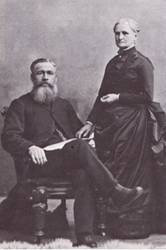To understand life in pioneer times we must revise our concepts of distance and time. Journeys which today take an afternoon, in pioneer times were overnighters. For those two-day trips, it would be nice if, say, half way through the trip, there was a place one could stop for shelter and food. Hence the “stopping house”, sometimes called the “halfway house”.
Like so many aspects of pioneer life, their operation was informal, unregulated and a direct response to a real need.

The decision to operate a stopping house might have been a reaction to circumstance. When you discover that your homestead happens to be in the right location, and you don’t mind some company from time to time, why not go into the business?
Mrs. E. Weightman, a widow with children, arrived on her homestead near Dand in 1882. She must have noticed that, being on a route between Brandon and the Land Titles Office at Deloraine, there was considerable traffic. Deciding to operate a stopping house was a way of taking advantage of an opportunity provided.
Location was the key. Advertising and promotion were by word of mouth. Often regular travellers to Brandon would plan their trips around the location of the stopping houses. The Black Creek Stopping House near Wawanesa was a made famous by Nellie McClung in both her fiction and memoirs.
Reputation also mattered. Even after decades had passed, an early resident of Deloraine remembered Mrs. Fox’s stopping house on the trail from Emerson to Boissevain as having especially good food.
Reservations were informal, but even then, advance bookings were accepted. Tom Guest and his sister Emily, a recent widow, operated a stopping house in the Montefiore district. Emily remembered “People would send word ahead (that) they would like to stay for meals and feed their horses. Some would stay the night.”
One never hears of a traveller being turned away. There was always a way to squeeze one more in – even if the hayloft had to be used.
Halfway Houses were a combination; restaurant, lodging, and livery stable. It was like a bed and breakfast with an extra meal thrown in – plus a gas station to fuel up your horse!
It was, of course, no coincidence that the role of informal innkeeper often fell upon those who got there first. The first stopping place known to operate in southwestern Manitoba was at “Old Wakopa” where Bernard LaRiviere had set up shop in an abandoned Boundary Commission building and started offering a variety of services to people on what was the main (only?) highway through the region. The shack erected by Elliott and Gould, the first settlers at Sourisford (further west along that Boundary Commission Trail), was soon recognized as a stopping place, as was the home of William Walker in the Lyleton district.
When John Renton and his family came west in 1880, they settled within a mile of the Land Titles Office, it was a natural place for a stopping place. It was also a natural place to hold church services – guests arriving on a Saturday night would likely have appreciated that.
The earliest stopping houses also acted as informal postal outlets until a proper post office could be applied for and established. This was true of the Elliott and Gould homes, and some operators like John Nelin, who was located along the Heaslip Trail.
The farm home operated by Henry Dann, near Lyleton, soon became the Butterfield Post Office in addition to offering travellers a place to stay.
Several places catered to the many established settlers who needed to make trips to Turtle Mountain for wood. Henry Albert Harris ran a stopping place where Primrose School was later located. It was perfectly placed for teamsters hauling to the Elgin and Souris areas.
The need faded somewhat as the railway reached into the southwest and towns were created. The long trips to Brandon were ended. Boarding houses and hotels were quickly built and these met the needs of the travelling public.
As late as 1890 John Walton operated a stopping house on a rented farm near Deloraine to service “all the teams hauling grain and provisions to and from this western area”. There is little mention of them after that, but for that short time between the arrival of first settlers in about 1878, until the establishment of towns, between 1885 (Boissevain) and 1890 (Hartney and Melita), there were at least a dozen of these important and interesting institutions - perfect examples of the practical pioneer approach to meeting a need.

. . . . .
Author: Ken Storie
Sources:
Boissevain History Book Committee. Beckoning Hills Revisited. “Ours is a Goodly Heritage” Morton – Boissevain 1881 – 1981. Altona. Friesen Printing, 1981 Brenda History Committee. Bridging Brenda Vol. 1. Altona. Friesen Printers, 1990 Melita - Arthur History Committee. Melita: Our First Century. Altona. Friesen Printers, 1983 Deloraine History Book Committee. Deloraine Scans a Century 1880 - 1980: Altona. Friesen Printers, 1980
Map adapted from:
Brownlee, J. H. Railway & Guide Map of Manitoba. 1:760,320. Winnipeg: Manitoba Department of Agriculture, 1887.
